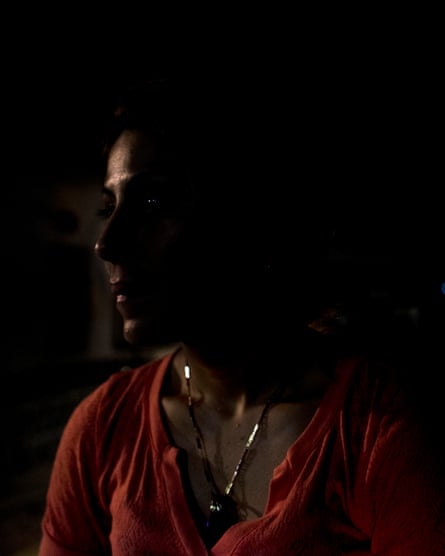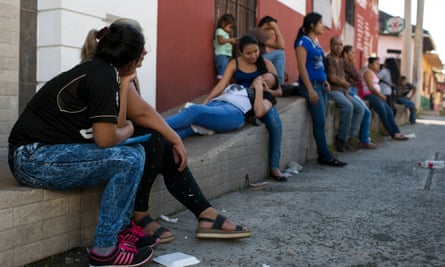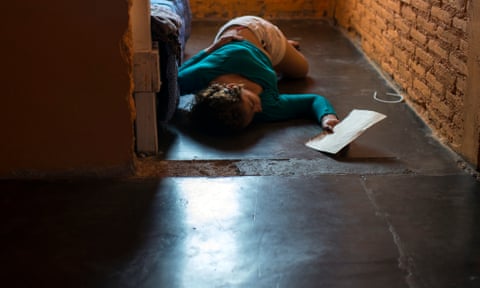Sara Rincón was walking home from college in the capital of El Salvador when she was confronted by three heavily tattooed gang members who had been harassing her for weeks.
The group’s leader – a man in his 30s, with the figure 18 etched on to his shaven head – threw her against a wall, and with his hands around her neck gave her one last warning.
“He said no woman had ever turned him down, and if I refused to be his girlfriend, he would kill me and my family. I didn’t want to leave home but after that we couldn’t stay; we left for Mexico in the middle of the night,” said Rincón, forcing a smile through her tears.
Increasing numbers of women and girls are fleeing El Salvador, Guatemala and Honduras amid mounting evidence that criminal gangs are systematically targeting adolescent girls as sexual slaves.
More than 20 years after peace deals were signed to end vicious conflicts between the region’s leftwing guerrillas and US-backed dictatorships, the three countries of the so-called Northern Triangle are still struggling with the consequences of war.
Corrupt security forces, international drug cartels and warring street gangs have helped turn the Northern Triangle into the world’s most dangerous region outside an official war zone. And the threat of sexual violence against women and girls has become a growing factor behind the refugee crisis that is quietly unfolding on America’s doorstep.

Of the 32,142 female migrants detained by Mexican immigration agents in the first nine months of this year, almost one in three were under 18. Almost 15,000 12- to 17-year-old girls from Central America’s northern triangle – Guatemala, El Salvador and Honduras – have been apprehended here since 2014.
Forcing women and girls into sexual activities with gang members is prima facie evidence of modern slavery, according to Urmila Bhoola, the UN’s special rapporteur for contemporary slavery.
“The forced recruitment of girls and young women into gang-related activities, and especially being forced into prostitution through providing ‘conjugal visits’ to gang members in prison, are extreme forms of sexual exploitation and human degradation that involve exercising powers akin to the right of ownership over these individuals,” Bhoola said.
“Gangs reflect the deeply patriarchal power structures that prevail in this region,” she said. “It’s a problem affecting millions of women and girls.”
But it is a phenomenon that regional authorities still deny, according to Erika Guevara, the Americas director at Amnesty International.
“Women and girls are living in a constant state of terror … treated as mere trophies in a ruthless war between gangs that largely control their countries. Authorities must invest some of the millions they are receiving to halt immigration in programmes to ensure these women are safe at home,” Guevara said.

For Rincón, the nightmare started in March, when the leader of a local clica, or neighbourhood cell, of the Calle 18 street gang started targeting her.
“Every time I got on the bus he’d be there, shouting that I was his girlfriend. Then, he sent guys to watch me. If they saw me talking to male friends, they’d tell them to back off, so I stopped going to college,” said Rincón.
In 2014 and 2015, at least 66,000 girls in El Salvador changed or abandoned school, according to ministry of education figures, in a country of 6.5 million people.
Rincón and her father fled north, and they are now sharing a tiny room in Tapachula, the biggest city on Mexico’s southern border, while they apply for refugee status.
But they could not afford the passage for the whole family, so her mother and five siblings are staying with relatives in another part of San Salvador – part of a growing wave of internally displaced people in the country.
They escaped the immediate threat, but the whole family is deeply traumatised.
Rincón is anxious and tearful – and she has started self-harming. “It feels like I’m trapped. I miss my mum. Cutting myself feels like a release. I just want this all to end,” she said. She recently turned 18, and wants to finish high school.
Her father Ricardo, 40, a shoe seller and evangelical pastor, recounts the ordeal in barely audible whispers and complains of a constant headache. He refuses to allow Rincón to make new friends because he is terrified the gang will track them down.
Increasingly, entire families from the Northern Triangle are fleeing together, seeking to escape warring street gangs and corrupt security forces.
Andrea Hernández, 17, is staying in one of Tapachula’s migrant shelters with eight members of her family. They fled Tegucigalpa, Honduras, one night in June, soon after Hernández was rescued from a gang kidnapping.
She was abducted on her way to a sports field for a morning run, and held captive for a week by gang members who wanted to recruit her, according to her mother Isabel, 54.
Andrea was rescued by the authorities after Isabel pleaded with a relative who works in the prosecutor’s office, but that was not the end of the ordeal: although the family begged officials not to make any arrests, they still feared retaliation from the gang.
The entire family – Hernández, her parents, her younger sister, 13, as well as her older sister, 28, and her husband and three children – fled the country.
“We left our dogs and cat, all my clothes, I couldn’t even say goodbye to my friends,” said Hernández.
So far, she has barely spoken about her seven-day ordeal at the hands of the kidnappers: “I can’t,” she said, turning her face to rub her eyes, “I’ve tried but I can’t.”
According to Isabel, her daughter cries at night, when she thinks the rest of the family is asleep. “She hardly eats, she’s traumatised, she’s not the same. My daughter was a model student in Honduras, she wanted to be an architect. Everything changed, for all of us, in one day,” said Isabel.
Two-thirds of the women interviewed by the UN refugee agency in 2015 described direct threats and attacks by members of criminal groups as a key reason for their flight.
But leaving home doesn’t guarantee safety, and there are growing reports that criminal groups and gangs are seeking out and targeting Central American migrants and refugees.
Soon after arriving in Tapachula in July, Andrea enrolled in a beauty course at another shelter. A month into the course, after a minor disagreement, two young Salvadorans told her she had five days to drop out or be killed. The family was forced to flee again.
“If we’re not safe here either. Why can’t we go home?” said Hernández, before walking out of the room.
“She doesn’t understand the dangers – we’re never going back,” said her mother.
Hernández and her family are also applying for refugee status in Mexico – part of a growing number of migrants seeking asylum here after a Washington-backed crackdown launched in July 2014 made it much harder to reach the US.
Mexico’s refugee agency (Comar) has a local office on a quiet corner in Tapachula’s historic centre. It recently extended its opening hours to tackle growing demand, but new applicants must still queue early in the morning to be seen.

Elena Cruz, 15, from San Salvador sat silently next to her mother Barbara, 39, clutching a folder of documents to show Comar.
She told a familiar story: a tattooed gang leader took a liking to Cruz. He started following her to and from school, and sending her threatening messages via a classmate.
“It was always the same, ‘if you don’t go out with me, you won’t go out with anyone’,” said Cruz. “I want to be a doctor but I had to stop school. I was terrified to be in the house as he knows where we live.”
Cruz’s mother moved her four times to live with different relatives, but each time the gang tracked her down. “They would send me messages on Facebook telling me where I was, threatening to come and take me.”
Too scared to go to the police in case the gang found out, mother and daughter packed two suitcases, and fled in the middle of the night, abandoning their home and Barbara’s successful seafood market stall.
“We’re seeking refuge because they’ll take my daughter or kill us if we go back,” said Barbara. “There’s no future in El Salvador, it’s now a crime for girls to be young and pretty.”
Names have been changed to protect identities
